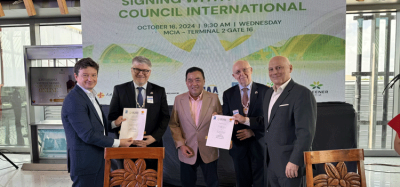Working together to combat the threat of climate change
- Like
- Digg
- Del
- Tumblr
- VKontakte
- Buffer
- Love This
- Odnoklassniki
- Meneame
- Blogger
- Amazon
- Yahoo Mail
- Gmail
- AOL
- Newsvine
- HackerNews
- Evernote
- MySpace
- Mail.ru
- Viadeo
- Line
- Comments
- Yummly
- SMS
- Viber
- Telegram
- Subscribe
- Skype
- Facebook Messenger
- Kakao
- LiveJournal
- Yammer
- Edgar
- Fintel
- Mix
- Instapaper
- Copy Link
Posted: 28 September 2015 | Michael Gill, Executive Director of the Air Transport Action Group (ATAG)
Michael Gill is Executive Director of the Air Transport Action Group (ATAG) – the only global association that represents all sectors of the air transport industry. Its mission is to promote aviation’s sustainable growth for the benefit of global society. Here, Michael explains why this year is important where climate change is concerned, and highlights that airports, airlines and manufacturers should all play their part to help make a big difference and meet targets…
With the UN’s COP21 climate negotiations taking place in late-2015 in Paris, hopes are high for a robust deal on climate change. Industrial sectors worldwide are expected to play their part and the aviation industry, including airports, is ready.
The global commercial aviation industry produces around 700 million tonnes of carbon dioxide annually which accounts for roughly 2% of man-made CO2 emissions. However, reducing the carbon intensity of aviation is a challenge this industry is determined to face head-on.
In 2009, ATAG harnessed the industry to agree on the following three ambitious, but achievable, goals: 1) An average annual 1.5% improvement in the fuel efficiency of the world fleet (a goal which the industry is currently meeting); 2) Stabilising net aviation CO2 emissions at 2020 levels through carbonneutral growth; and 3) Halving aviation’s net CO2 emissions by 2050 (when compared with a 2005 baseline).
To ensure these are met, the industry has developed a four-pillar strategy, focused on technological innovation, operational efficiencies, infrastructural development and a global market-based measure (GMBM).
Progress in all areas has been encouraging. We have recently seen technological progress through the utilisation of lightweight composite materials in the production of aircraft, and we are now also beginning to reap the weight and energy saving rewards of 3D printing in the production process. Jet engines have also become progressively more efficient.
Sustainable alternative fuels also make up part of the technology pillar. Biojet fuel, currently being piloted, can be up to 80% less carbon intensive than traditional fossil-based jet fuel and represents a crucial element in aviation’s climate action framework. More-and-more innovative feedstock solutions are being identified every year, from municipal waste to algae and nicotine-free tobacco – all of which have been designed not to compete with essential agricultural resources and be sustainably produced, which is crucial to the long-term viability of alternative fuels.
Elsewhere, improved navigations services have produced important savings in fuel through smarter routing, and airlines have made great efforts to create operational efficiencies through reducing the weight of cabin equipment and cutting down on wasteful fuel burn while taxiing.
ATAG are playing a central role in representing the industry at international negotiations through the specialised UN agency, the International Civil Aviation Organisation (ICAO), to secure an agreement on a global market-based measure (GMBM) for aviation emissions. The process at ICAO has shown encouraging momentum and the industry is confident that a comprehensive agreement on a GMBM will play an important role in the sustainable development of aviation. It is, however, vital that this agreement is global in nature and preserves fair competition between airlines.
The infrastructure strategic pillar is where airports have the most important role to play. Whereas aircraft must ultimately rely on jet fuel, airports have the potential to take advantage of all manner of carbon-cutting measures. Many airports are using renewable energy for heating and cooling terminals, using LED lighting, electric ground vehicles and lots more.
To recognise and promote good environmental practice at airports, Airport Council International (ACI) has established the Airport Carbon Accreditation programme which has the ultimate goal for all airports operating on a carbon neutral basis. The programme works by setting four levels of accreditation: mapping, reduction, optimisation and neutrality. Airport Carbon Accreditation has been growing since its initial launch in Europe, with 92 European airports now accredited to at least Level 1. The scheme has since been rolled-out to other regions and expectations are high that many more airports will soon achieve carbon neutrality. Currently there are 20 airports that have achieved Level 4 accreditation, all of them in Europe. These airports have shown that carbon neutrality is possible and the challenge has now been set for others to follow. It’s an excellent programme and one that is being matched by emissions-reduction efforts across the sector.
With airports, airlines and manufacturers all playing their part, plus with proper engagement from governments and international institutions, we are confident the aviation industry will meet its emissions goals and contribute to combatting the threat of climate change.
Biography
Michael Gill was appointed Director, Aviation Environment of the International Air Transport Association (IATA) in November 2013. Prior to that, Michael spent six years as Senior Legal Counsel in IATA, supporting IATA’s external affairs portfolio. In that role, he led IATA’s delegation to three ICAO diplomatic conferences on airline regulatory and security issues. Before joining IATA in May 2007, Michael was an aviation lawyer in private practice acting for airlines and their insurers. He holds law degrees from both King’s College London and the Sorbonne University in Paris, as well as a Master’s Degree from the University of Edinburgh. He is admitted as a solicitor of the Supreme Court of England and Wales and an avocat in France.


















